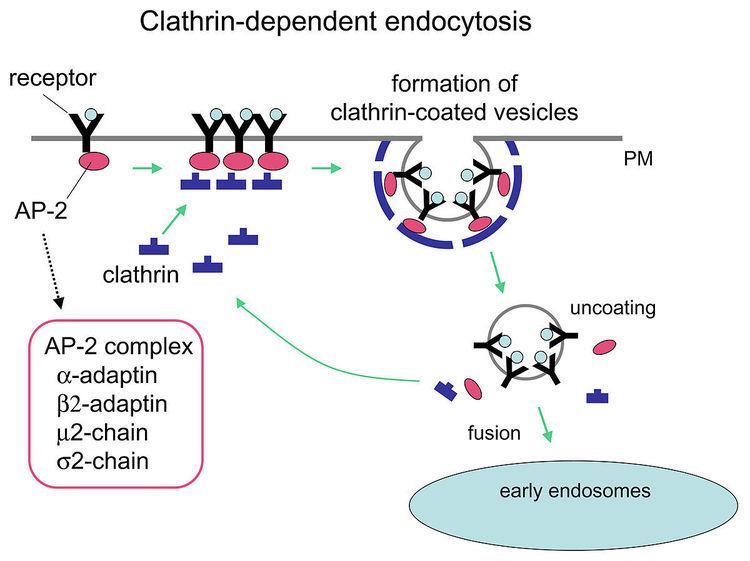 | ||
Receptor-mediated endocytosis (RME), also called clathrin-mediated endocytosis, is a process by which cells absorb metabolites, hormones, other proteins - and in some cases viruses - (endocytosis) by the inward budding of plasma membrane vesicles containing proteins with receptor sites specific to the molecules being absorbed.
Contents
Process
Although receptors and their ligands can be brought into the cell through a few mechanisms (e.g. caveolin), clathrin-mediated endocytosis remains the best studied. Clathrin-mediated endocytosis of many receptor types begins with ligand binding and receptor. The ligand and receptor (sometimes bound to an adaptor protein) then diffuse through the plasma membrane until captured by a preformed or forming clathrin-coated pit. Other receptors can nucleate a clathrin-coated pit allowing formation around the receptor. A mature pit will pinch off from the plasma membrane forming a clathrin-coated vesicle that then uncoats and typically fuses to an early endosome. Once fused the endocytosed cargo (receptor and/or ligand) can then be sorted to lysosomal, recycling, or other trafficking pathways.
Function
The function of receptor-mediated endocytosis is diverse. It is widely used for the specific uptake of certain substances required by the cell (examples include LDL via the LDL receptor or iron via transferrin). The role of receptor-mediated endocytosis is well recognized in the downregulation of transmembrane signal transduction but can also promote sustained signal transduction. The activated receptor becomes internalised and is transported to late endosomes and lysosomes for degradation. However, receptor-mediated endocytosis is also actively implicated in transducing signals from the cell periphery to the nucleus. This became apparent when it was found that the association and formation of specific signaling complexes is required for the effective signaling of hormones (e.g. EGF). Additionally it has been proposed that the directed transport of active signaling complexes to the nucleus might be required to enable signaling as random diffusion is too slow and mechanisms permanently downregulating incoming signals are strong enough to shut down signaling completely without additional signal-transducing mechanisms.
Experiments
Using fluorescent dyes to stain the plasma membrane, it is possible to follow the internalization of plasma membrane fragments by microscopy.
Since the process is non-specific, the ligand can be a carrier for larger molecules. If the target cell has a known specific pinocytotic receptor, drugs can be attached and will be internalized.
